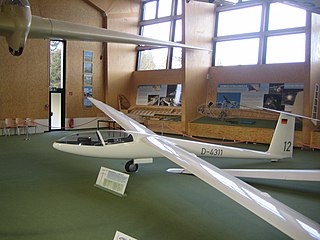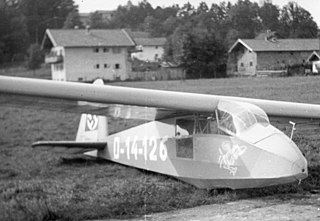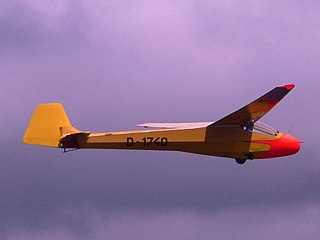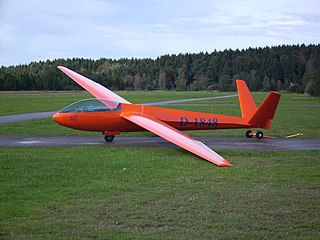
The ASW 12, initially known as the AS 12, is a single-seat Sailplane of glass composite construction. The wing is shoulder mounted and it has a T-tail. It is essentially a developed production version of the Akaflieg Darmstadt D-36.

The Schneider ES-65 Platypus is a two-seater unflapped glider designed and built by Edmund Schneider Ltd in Australia. A single prototype was built, which remains operational as of 2012.

The Akaflieg Stuttgart fs24, nicknamed Phönix, was a glider designed and built in West Germany from 1951.

The Schleicher ASK 18 is a single-seat sailplane that was built by the German manufacturer Alexander Schleicher GmbH & Co. It was designed to be a sturdy aircraft for inexperienced solo pilots and so uses a simple and rugged construction and has docile handling characteristics.

The SZD-24 Foka (Seal) was a single-seat high-performance aerobatic glider designed and built in Poland in 1960.

The Scheibe Bergfalke is a German glider designed by Egon Scheibe as a post-World War II development of the Akaflieg München Mü13 produced before and during the war.

The Akaflieg München Mü10 Milan is a two-seat glider aircraft that was designed in Germany in 1934. Only one copy of the design was built.

The Akaflieg München Mü17 Merle is a single-place glider aircraft that was designed and built in Germany from 1938.

The Akaflieg München Mü22 is a single-seat research glider designed and built in Germany from 1953.
Akaflieg Darmstadt is one of approximately twenty aviation groups attached to German universities. Akaflieg is an abbreviation for Akademische Fliegergruppe, an academic group of students and faculty from a German University.
The Manuel Hawk was a homebuilt single-seat glider designed and constructed in the UK around 1970. Only one example was flown.
The Akaflieg Darmstadt D-34 sailplanes were a series of experimental single seat sailplanes, designed at the University of Darmstadt in the 1950s and early 1960s to explore the structural and aerodynamic advantages of the then emerging plastics and composite materials.

The Akaflieg Darmstadt D-36 Circe is a single seat, high performance sailplane designed and built in Germany in the mid-1960s, one of the early "glass ships". It was the winner at the German National Championships in 1964 and came second in the World Championships the following year.
The Akaflieg Darmstadt D-40 is an experimental variable geometry single seat sailplane, fitted with almost full span, camber changing flaps for optimum aerodynamics in weak thermals and integrated into the wing so as to minimise flap tip drag. One flew successfully but the D-40, like other variable geometry sailplanes, was not commercialised.
The Akaflieg Braunschweig SB-11 is an experimental, single seat, variable geometry sailplane designed by aeronautical students in Germany. It won the 15 m span class at the World Gliding Championships of 1978 but its advances over the best, more conventional, opposition were not sufficient to lead to widespread imitation.
The Akaflieg Braunschweig SB-7 Nimbus is a Standard class glider designed and built in Germany in the 1960s. It was one of a series of mixed glass fibre and wood designs from the students of Akaflieg Braunschweig.
The Akaflieg Braunschweig SB-8 is an experimental, single-seat, high performance glider built in Germany in the 1960s, constructed largely from glass fibre skin over built up balsa wood structure. Two were built; the second of which was later fitted with a high aspect ratio (30:1) wing, becoming the Akaflieg Braunschweig SB-9 Stratus.

The Siebert Sie-3 is a single-seat Standard class glider designed and produced in Germany in the 1960s for club use.

The Mistral-C was one of the first gliders, designed in 1974 to the then new Club Class rules. It was based on the Strauber Mistral, a Standard Class glider flown a year earlier, but with a new wing and built from newer composite materials. Both types were designed and constructed in Germany. More than 75 Mistral-Cs were produced.
The Akaflieg Braunschweig SB-6 Nixope was an early (1961) GRP high performance single seat glider designed and built in Germany by aeronautical students from Brunswick University. It competed in the 1961 German National gliding competition, coming sixth, and led directly to two further GRP aircraft.










